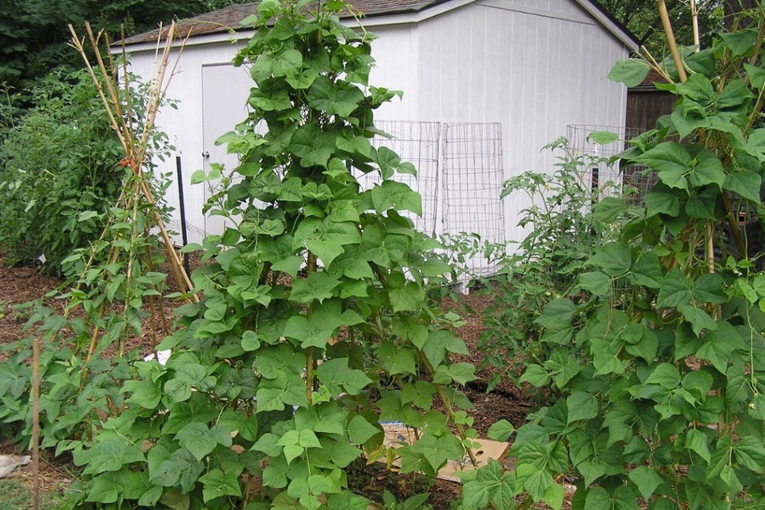From an article previously published in The Ecozoic Review
I’ve kept a food garden most of my adult life, and by now that would be more than fifty years of practice. Through all the years of raising children and going to my day job forty or fifty hours a week, the garden was my primary passion and exercise. I’ve been slow to realize that the way of life I’ve chosen—placing this human-Earth practice with such deep historic roots at the top of my priorities—is wildly uncommon now in our country, even among foodies and ardent environmentalists. To devote the best hours of the day, almost every day, to caring for a substantial number of food plants would require a drastic departure from what our society encourages. A normal life for moderately affluent and healthy adults today includes a lot more going out than I have time for: to restaurants, to the gym, to educational, entertainment, social, or activist events. People with children have all those activities for their offspring as well as for themselves. They also travel. They take vacations! Imagine!
Actually, I’ve been able to do most of those things along the way, but in measured amounts. To practice the growing of enough fruits and vegetables to live on requires interspersing a little bit of going out with a lot of staying at home—reversing the location of activities from what is more normal in our culture. I’ve been active in the important social and environmental justice endeavors of my era; I have family and close friends to visit with; I sometimes travel; but all the while a large array of plants are tended by me or by another trained caregiver as if my life depended on them, which it does.
It is probably not surprising to know that friends have been quick to say yes when I want garden help, and people often ask if I need it. They like to be in gardens, and they enjoy learning gardening skills. It seems humans have an affinity for growing things. It’s only the degree of my immersion in the project that is different from what is more standard. Most people have the inclination, and in the garden classes I teach and with interested visitors that’s what I try to encourage. I want them to have the experience of bringing an easy-to-grow vegetable from seed to table. The thrill of competence in this fundamental human task is as rewarding to the soul as the plant’s nutrients are to the body.
So what does a sustenance vegetable garden look like?
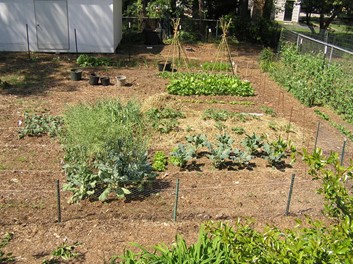
Seen in the early spring of 2013, here is the 35’x27’ garden I kept at my former home in Raleigh. The picture below shows how that garden looked in mid-summer’s abundance.
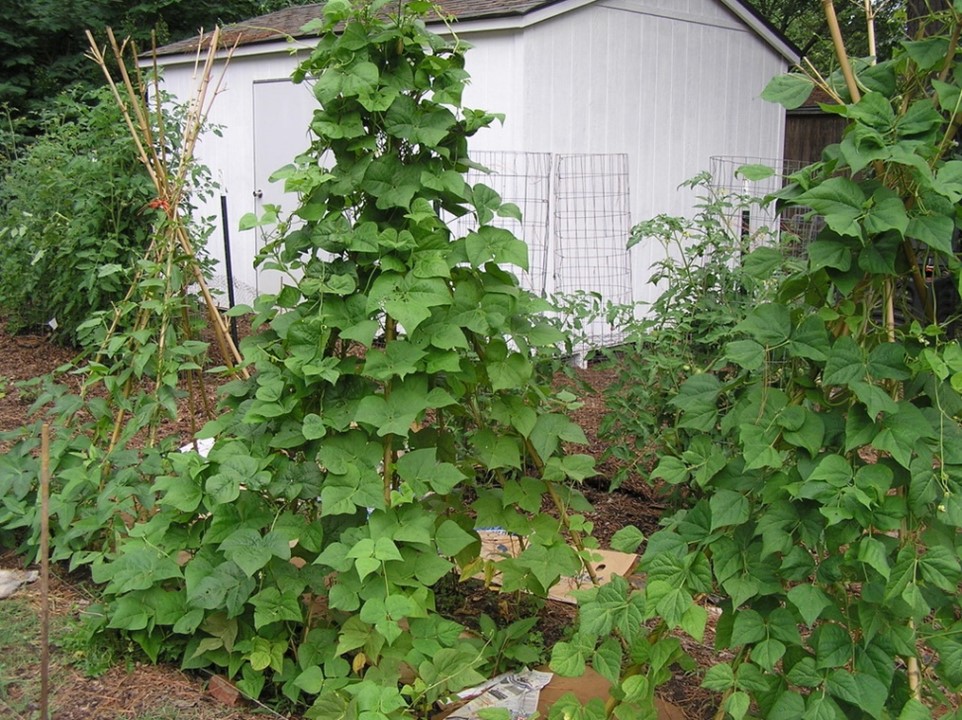
Kentucky Wonder pole beans climb those teepees that had been bare in early spring, and tomato vines can be seen in cages behind the beans.
Last year one of my daughters and I moved into an intentional community where land was set aside for a community garden that is now in its third year. Gardening with others is the perfect arrangement for an older gardener. My partners value my knowledge and I value their strength. I’m writing this article in early July, when we recently dug our Irish potato harvest. Ideally potatoes in storage need darkness at 40 degrees F., and in summer in central North Carolina that temperature is not possible. I’ve had some success keeping them for a few months by wrapping them individually in newspaper, so we’ve stacked them 3-high in boxes in our laundry closet. With so many potatoes to eat before they shrivel, we enjoy them almost every day. It’s lucky we’re Irish.
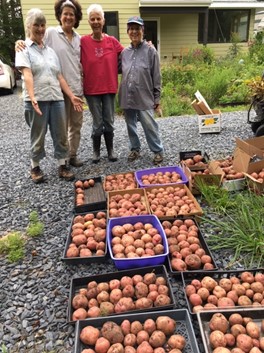
Below top to bottom: potato croquettes, hash browns, and potato salad. We also like them mashed, boiled and buttered, and fried with sliced hot dogs. We eat meat a few times each week; ours comes from pastured animals—usually ground pork, lamb, beef, goat, or water buffalo served as patties. In the photos you can see other midsummer produce: fried eggplant, brined sliced cucumbers, and green beans. As often as potatoes, we also have cooked greens. Now we’re alternating kale, Swiss chard, Florida Broadleaf mustard, and turnip greens.
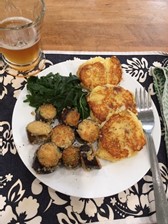


The turnip greens we plant are Seven Top, a variety that produces amazing greens—not turnip roots—from April to August and then again in autumn in our region. It is a nutritious crop that thrives in drought, cold, and summer heat. To those of you who aren’t from the US South, these are cooked greens; women transported from Africa to be slaves brought similar plants here as seeds, perhaps woven into their braids as suggested by Leah Penniman, and taught white slave owners how to season them with hog fat and serve them with cornmeal bread.
The core work group meets at 8 am in the garden almost every day to water, weed, harvest, and conduct critter patrol. Last year we put up our deer fence after you-know-who made a meal of the sweet potato beds, and this year a rabbit scythed our new bean plants before we tracked down his entryway under the chicken wire. We spent a day or two on our knees as we re-secured the wire to the ground around the whole perimeter. With potato bugs and Japanese beetles we tap them into jars of detergent water. In July the stink bugs that are the menace of tomato growers now on most of the East Coast are just starting to appear. They exchange juices with the tomatoes, leaving fruits that look perfect when picked, but show bruises in a day or two and soon rot.
The insects that are the most troubling to us, though, are the ones that prey on the gardeners—ticks, mosquitos, midges, spiders, and the worst in my mind, fire ants. In this neighborhood we built our homes and put in our garden beds on land they had been working, and their belligerent nature makes co-existence hard. Where my daughter and I have planted sweet corn and watermelons at the foot of our hill, the fire ants are so prevalent we can’t stand long in one place, and wouldn’t dare sit or kneel on the ground, as I’ve been accustomed to doing while I weeded. I think all of the garden partners carry a dozen or more bites at any one time from one insect or another.
But who would give up sweet corn and watermelons—or potatoes, beans, strawberries, or garlic—for fear of ant bites? If only the health benefits of raising food are factored in, the good far outweighs the bad of the itches and stings, and I’m not referring to the daily exercise, an indisputable gain. If only nutrition is considered, the organic home gardener has the advantage over not just the grocery store but also over large-scale organic growers. We can create permanent beds, raised or not, without disrupting nature’s soil-building techniques, upon which no one can improve for lack of full understanding. In our case we let the rich though compacted red clay of the Piedmont serve as the bed floor, to which we add brought-in topsoil, cow manure, leaves, or hay, as well as the cardboard or newspaper we utilize as mulch for weed control. When we harvest a crop we leave roots in the ground unless we’re going to eat them. The organisms which play such an important role in fertility take all these inputs and of them make that miracle substance, humus.
I feel fortunate that I’ve had five decades in which to learn how to serve the plants who produce food for humans to eat. These skills rise in importance as more and more studies predict food shortages caused by our changing climate. I’m living now in a part of the world that is not likely to face either extreme drought or rising seas; short-term threats to the US Southeast are expected to be more drastic versions of what we have now: summer thunderstorms, insects, and hot, muggy weather. I’d feel insecure if I didn’t have a sunny site with a dependable source of water—in our case a river—and knowledge about how to nourish soil to counter as much as possible the plant nutrient loss being caused by higher levels of CO2.
Rising emissions, habitat destruction, biological disruption, and warming feedbacks all indicate to me that political and economic instability are also in our future, and possibly not far away. I’m hoping to encourage readers to consider the benefits of starting now to grow more of their own food. At this point my life passion is beginning to look quite sensible. It might appear that I made logical decisions as I chose my primary life practice. Instead I only followed my heart, and as the wise ones know, that is often the safest path.
All images courtesy of the author.


